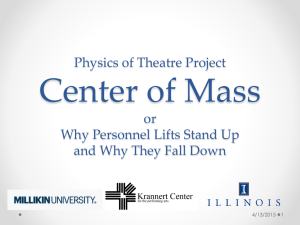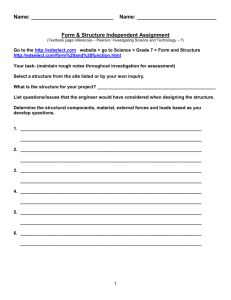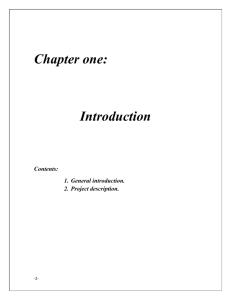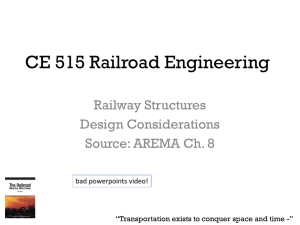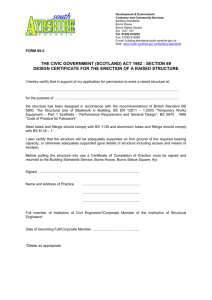Mid-term test ”Havkonstruksjoner”
advertisement
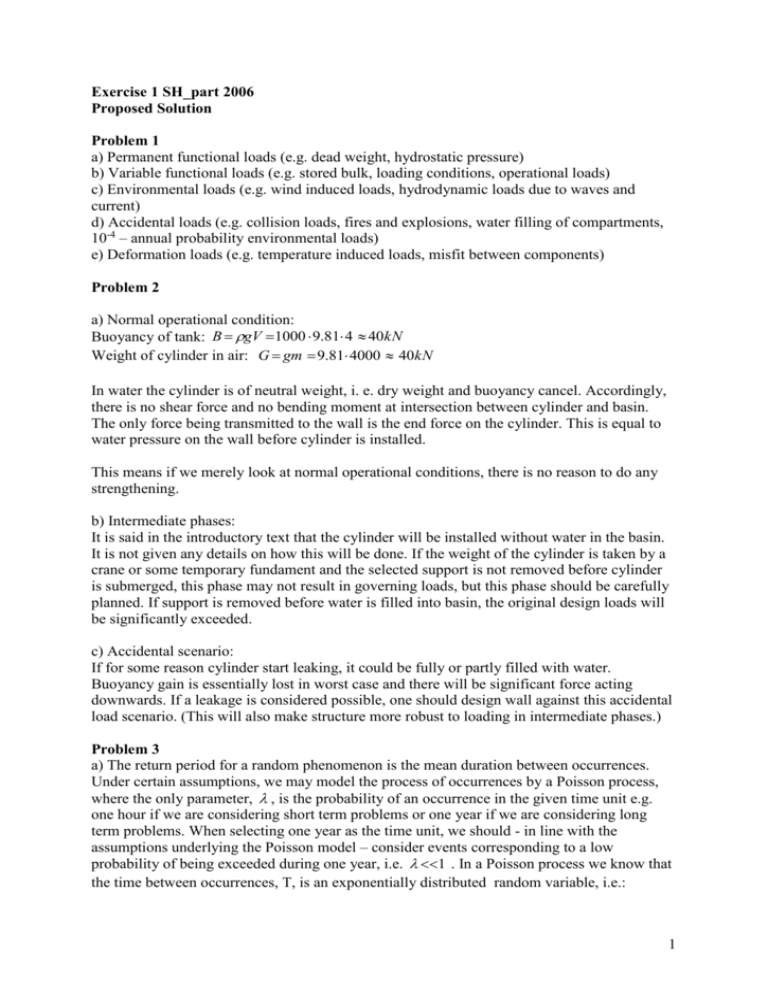
Exercise 1 SH_part 2006 Proposed Solution Problem 1 a) Permanent functional loads (e.g. dead weight, hydrostatic pressure) b) Variable functional loads (e.g. stored bulk, loading conditions, operational loads) c) Environmental loads (e.g. wind induced loads, hydrodynamic loads due to waves and current) d) Accidental loads (e.g. collision loads, fires and explosions, water filling of compartments, 10-4 – annual probability environmental loads) e) Deformation loads (e.g. temperature induced loads, misfit between components) Problem 2 a) Normal operational condition: Buoyancy of tank: B gV 1000 9.81 4 40kN Weight of cylinder in air: G gm 9.81 4000 40kN In water the cylinder is of neutral weight, i. e. dry weight and buoyancy cancel. Accordingly, there is no shear force and no bending moment at intersection between cylinder and basin. The only force being transmitted to the wall is the end force on the cylinder. This is equal to water pressure on the wall before cylinder is installed. This means if we merely look at normal operational conditions, there is no reason to do any strengthening. b) Intermediate phases: It is said in the introductory text that the cylinder will be installed without water in the basin. It is not given any details on how this will be done. If the weight of the cylinder is taken by a crane or some temporary fundament and the selected support is not removed before cylinder is submerged, this phase may not result in governing loads, but this phase should be carefully planned. If support is removed before water is filled into basin, the original design loads will be significantly exceeded. c) Accidental scenario: If for some reason cylinder start leaking, it could be fully or partly filled with water. Buoyancy gain is essentially lost in worst case and there will be significant force acting downwards. If a leakage is considered possible, one should design wall against this accidental load scenario. (This will also make structure more robust to loading in intermediate phases.) Problem 3 a) The return period for a random phenomenon is the mean duration between occurrences. Under certain assumptions, we may model the process of occurrences by a Poisson process, where the only parameter, , is the probability of an occurrence in the given time unit e.g. one hour if we are considering short term problems or one year if we are considering long term problems. When selecting one year as the time unit, we should - in line with the assumptions underlying the Poisson model – consider events corresponding to a low probability of being exceeded during one year, i.e. 1 . In a Poisson process we know that the time between occurrences, T, is an exponentially distributed random variable, i.e.: 1 FT (t ) 1 e t The expected value of T is the return period for the considered event, i.e: rT E T 1 This expression shows that the return period is the inverse of the probability of being exceeded during the selected time unit, here one year. This means that if is given as a probability per year, rT as given above is the return period in years. b) The return period is in line with what is said above given by: rT 1 200 years 0.005 c) The probability of exceeding the load level in an arbitrary 3-hour period is: Q3h 1 P3h 1 0.999994 6 10 6 Assuming that the stationary assumption is fulfilled, the return period of this event is: rT _ 3h 1 166666.7 3-hour periods Q3h i.e. since exceedance probability refers to 3 hours, the return period is given in terms of 3hour events. Since we have 2920 3-hor events per year, the return period in years is: rT _ years 166666.7 57.1 years 2920 Thus the annual exceedance probability is: Q1-year = 1/57.3 = 0.0175 Problem 4 It is referred to the figure at the top of page 2-3 in the lecture notes available on the course web site. This figure shows all forces acting on a pipe segment. We can write this force pattern as a sum of three contributions as shown by the 3 figures at the bottom of page 2-3: a) Buoyancy of an isolated member: By introducing fictitious end plates a closed body is achieved. The result is that we know that the resulting force is the buoyancy force and that it acts vertically upwards. b) Pressure of internal fluid: Again with these fictitious end plates, the resulting force on the element is the weight of the fluid and it vertically downwards. 2 c) Remaining forces: The third figure shows the remaining forces, i.e. the weight of the pipe wall in air, and the end tensions of the pipe segment. These forces are real existing forces. In addition, we have to correct for forces introduced on the fictitious end plates in a) and b), i.e. the external and internal end pressures. In this figure the end forces are introduced with opposite direction of what is used in a) and b), respectively. If we add all the forces (external pressure of a), internal pressure of b) and pipe weight, pipe wall tensions and the end pressures of c), it is seen that the load pattern is exactly what is the case for the upper figure. The advantage of writing the load pattern this way is that we can introduce buoyancy and fluid weight in a buoyancy sence, i.e. we know the directions of these resulting forces (pure vertical independent of pipe segment orientation). The disadvantage is the introduction of the fictitious end forces, pe*Ae and pi*Ai. When looking at the closed body model, the apparent weight is found by adding the weight components (buoyancy is considered a weight component) now always acting vertically from a) – c): we dl ( wr e gAe i gAi )dl One may say that the apparent weight is the weight of the body considered as a closed body by introducing fictitious end plates. The effective weight will always act vertically. The corresponding tension on the segment has to account for the fictitious end forces, i.e. the effective tension is: Te Ttrue pe Ae pi Ai Ttrue is the real pipe wall tension. One may say that the effective or apparent tension is the tension experienced on the ends of fictitiously closed body segment. The analysis will give Te. The true pipe tension can then be found from: Ttrue Te pi Ai pe Ae where: pe gh d Ai i 2 2 2 d Ae e 2 h - depth of the riser intersection di - inner diameter 3 de - outer diameter. Problem 5 a) Restoring force: Rz k z z gAW L k z gAW L 10 6 N / m Problem 6 a) In the last sentence in §4 it is said that areas where crew may be present shall not be hit by wave events corresponding to an annual occurrence probability of 1x10-2 or higher. In the guidance to §4 it is further said that this requirement can be met by technical solutions or by operational actions. The first would be to locate the working deck so high that it can not be hit by the 10-2 wave event. A proper operational action would be to close the deck for personnel as weather severity reaches a certain level. If an operational action is selected, i.e. it is accepted that the deck may be hit by a 10-2 wave event, one has to realize the global forcing are changed as compared to the original design. One may find more guidance in other regulations regarding modifications, in the Facilities Regulation, §10 requires that loads on the structure or the structural components corresponding to an annual exceedance probability of 1x10-4. It is required that the 10-4 – probability loads shall not represent loss of the structural integrity (see also § 6). This means that the working shall be controlled against 10-4 impact loads on the deck and the full structure shall also be shown to have sufficient margin to take the estimate increase in the 10-4 – probability load. Minor damage to the working deck may be acceptable. b) Safety functions are defined in § 6. Point b) gives some requirement regarding the overall structural integrity. c) § 10 gives some overall requirements to loads. The requirements are elaborated somewhat in the guidance to this paragraph. In the latter reference are made to other standarda, e.g. NORSOK-standards and DNV-standards. 4


